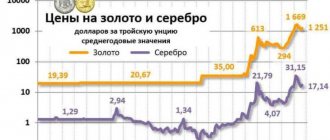Hello, dear blog guests, today we will talk about gold and exchange rates, and also consider the relationship that exists between them. Despite the fact that gold currently does not serve as a reserve asset, its current value still has a significant impact on the international foreign exchange market. Gold and exchange rates are closely related, since changes in the value of the eternal metal entail a rise or fall in the prices of various currencies.
Gold and exchange rates. Quote link
To understand why changes in the value of gold affect the quotes of modern currencies, we need a short excursion into history.
Previously, gold provided exchange rate insurance for various countries. Even during the period of the Byzantine Empire, the eternal metal was used as a guarantor when concluding transactions with various currencies, the quotes of which were not backed by gold. Until the 70s of the twentieth century, gold served as a reserve asset. The situation changed only after American President Nixon in 1971.
The action of the “gold standard” significantly limited the actions of the governments of various states to increase the money supply. This was due to the fact that, according to the rules of the “gold standard,” the volume of money supply in a particular state must correspond to the available reserves of gold.
Despite the fact that the “gold standard” was abolished more than 50 years ago, some experts in the field of economics propose returning to it, since, in their opinion, too high volatility of the dollar negatively affects the economic situation in the world.
Currently, gold is widely used by governments of various countries to hedge inflation. As a rule, the growth in demand for eternal metal increases significantly with the increase in inflation in the world economy. This is due to the fact that when there is instability in the international market, investors prefer to invest their available capital in gold, as it has its own value.
The main value of the eternal metal is that its total quantity is limited. Since gold cannot be created artificially, its quotes are more stable than those of existing currencies.
As an example, we can recall the situation that occurred in 2011. At this time, there was a threat of a significant decline in the value of major world currencies. For this reason, investors began to purchase gold, causing its price to rise to $1,500 per ounce.
Gold is coming: to save the world capitalist system, the dollar will have to be sacrificed
Gold was ordered to leave the world of money, it was demoted to an exchange commodity. However, it remained a competitor to the dollar and did not want to leave the world of money Photo: © Frank Rumpenhorst/dpa/globallookpress.com
Banishment of gold
What has long been a terrible secret in the world of finance and money is known to many today.
Namely: for decades, gold was vigorously banished from the world of money and its price suppressed. This policy was adopted by those who imposed the decisions of the 1976 Jamaica Monetary and Financial Conference, which decided to replace the gold-dollar standard with a paper-dollar standard. Gold was ordered to leave the world of money, it was demoted to an exchange commodity. However, it remained a competitor to the dollar and did not want to leave the world of money. Then it was decided to suppress the price of gold. The cynical formula was in effect: “The lower the price of gold, the stronger the dollar” (and vice versa: the higher the price of gold, the weaker the dollar). For four decades, the masters of money (the main shareholders of the US Federal Reserve System) waged a silent war against gold. At first, official gold interventions were carried out on the gold market (in the late 1970s) using the reserves of the US Treasury and the IMF. Then a secret gold cartel was created with the participation of the Federal Reserve Bank of New York, the Bank of England, a number of Wall Street banks and the City of London, playing to lower the price of gold. The cartel used metal from the official gold reserves of the United States and possibly England. In fact, gold was being stolen from official reserves, covered by false agreements on gold loans and gold leasing.
At the turn of the 20th–21st centuries, the so-called Washington Gold Agreement appeared, in which about two dozen Western states participated. The agreement required the monetary authorities to sell off gold from official reserves. At first, the agreement worked effectively (sales of gold by the central banks of Switzerland, England, France, Germany, etc.), but in the 2010s, the monetary authorities began to feel sorry for parting with gold. In the fall of 2021, the Washington Agreement was put to rest (it was not extended).
In parallel, a means of suppressing gold prices was used, such as financial instruments (derivatives) tied to the precious metal. These are various futures and options, claims (and obligations) denominated in gold. In 90-99% of cases, there was no actual delivery of physical metal. This is the so-called paper gold. The gigantic scale of trade in “paper gold” suppressed the price of physical metal. Exchanges that were said to be “gold” actually traded (and continue to trade) virtual (“paper”) gold. The world's largest gold trading platform is located in London, where the London Bullion Market Association (LBMA) operates. Here, gold is traded at an average of $20 billion per day, or more than $5 trillion. dollars per year. And almost all trade comes down to the purchase and sale of “paper gold”.
The world's second largest trading platform for precious metals is the New York COMEX exchange. Noted financial analyst Patrick Heller speaks about the exchange's role in suppressing gold and supporting the US dollar: “Trading in gold futures and options contracts on the COMEX began in the mid-1970s in order for the US government and major trading partners of the Federal Reserve Bank (FRB) New “York could have manipulated the price of gold.”
The main participants in the paper gold trade are banks. They work with two types of gold. The first is the so-called distributed gold, owned by bank clients; This is physical metal, identified (ingots of a certain standard, numbered), stored in specially equipped rooms. This gold is not reflected in the bank's balance sheet; it is an off-balance sheet asset.
The second type is undistributed gold. It is the property of the bank and is reflected in its balance sheet. The bank carries out various transactions with such gold, such gold is reflected in the assets and liabilities (liabilities) of the bank. A bank client, for example, may open a deposit of 1000 ounces of unallocated gold, and the bank's obligation is to repay the client's claims in foreign currency or metal form. Most metal transactions do not end with the delivery of physical gold. Therefore, banks have minimal reserves of physical gold (and sometimes zero). An analogy with cash suggests itself here. The cash at the cash desk of a commercial bank is sometimes thousands of times less than the total claims of all clients who have opened deposit accounts in this bank. In relation to gold, we can say that banks working with undistributed gold have incomplete (partial) coverage of their obligations on transactions with the precious metal.
Of course, this factor increases the instability of the bank. Some banks that specialize in working with undistributed gold may collapse during banking crises, sharp price fluctuations in the gold market, etc. In fact, the undistributed gold of banks is one of the varieties of “paper gold”. It is obvious that in order to increase the stability of banks working with gold, it is necessary to change the proportion of physical and “paper” gold in favor of the former. And if the bank does not want (or cannot) change this proportion and is inclined to work with “paper” gold, it must increase its own capital, which could cover the risks of working with unallocated gold.
Battle of Basel III
The Bank for International Settlements (BIS) in Basel has long been concerned about these issues. He is known to be developing capital adequacy standards for banks in order to increase the stability of credit institutions. The first generation of such standards was called Basel I. Then they were replaced by Basel II standards. And when the global financial crisis of 2008–2009 broke out, it became clear that the Basel II standards were insufficient, and that it was necessary to tighten the requirements for the size and quality of capital of commercial banks. The development and phased implementation of Basel III standards has begun, but they have not yet been fully introduced.
The issue of gold in the new Basel regulations is especially sensitive for many states and banks. At the beginning of 2021, there was a rumor that on March 29 of the same year, a new rule for accounting for gold as part of the equity capital of banks would come into force, making the precious metal attractive to banks. This encouraged banks to increase capital through gold. However, to the disappointment of many, no new rules were introduced. Someone put forward a version: the owners of the money managed to put pressure on the BIS and achieve the cancellation of the introduction of these rules, which undermined the position of the US dollar.
In 2021, the BIS renewed efforts to promote Basel III rules. Basel said that the new capital adequacy standards will come into force in full on January 1, 2023. It is customary for decisions at the Bank for International Settlements to be prepared in secret, but insider information about upcoming innovations in gold penetrated the media back in March of this year. The date has been announced when European Union banks will begin the transition to the new version of Basel - June 28, 2021. English banks are also aware and have been given the command to begin the transition on January 1, 2022.
Under the new rules, banks will be required to hold unallocated metals on their balance sheets at a value equal to 85% of the market price of gold. It follows that banks will have to sharply increase their share capital and reserves to secure transactions with such unallocated gold. This is an impossible requirement for banks. And, most likely, they will have to sharply reduce operations with “paper” gold or replace it with physical metal.
The impending tightening of Basel finally ceased to be a secret when on May 4 this year the LBMA and the World Gold Council (WGC) sent a request to the British Prudential Regulation Authority not to introduce Basel III standards for trading in unallocated precious metals (not just gold , but also silver): there are fears that the new rules will lead to the liquidation of the London "paper gold" market. It is surprising that VSZ joined the LBMA appeal. The latter has for many years portrayed itself as an organization protecting the interests of those who work with physical gold (gold miners, jewelry industry). Apparently, VZZ has long gone over to the side of those who work with “paper gold” and protect the US dollar.
The dollar doesn't have long to live
One of the well-known participants in the precious metals market, Mexican billionaire Hugo Salinas Price, reacted to the innovation in gold accounting within the framework of the new Basel. He has long said that there is an artificial reduction in prices for gold and silver on the world market. On May 31, Price published the article “June 28: Bank for International Settlements Caves Into Russia and China.” I quote the most important thing: “It was operations with “undistributed”, or rather with mythical gold, that allowed the most important banks in Britain and the USA to control and suppress the market price of gold. Under the new rules, which will be fully unveiled on June 28 this year, the price of gold will no longer be subject to manipulation by the US and Britain, because the most important banks in these countries will no longer be able to use “unallocated”, that is, non-existent, gold in a conspiracy to control the price of metal."
Why does Hugo Salinas Price say that the BIS is “surrendering to Russia and China”? I'm not sure that Moscow and Beijing put any pressure on the Bank for International Settlements in Basel to introduce new rules on gold. Yes, the BIS played along with the US dollar for a long time, but today the situation is such that it will no longer be possible to save the dollar. The dollar is hopeless. Its further support through the suppression of the price of gold is fraught with such a severe crisis that the financial crisis of 2008–2009. It will seem like a toy.
The BIS is forced to save the world capitalist system. And if the new BIS rules come into effect, they will be especially beneficial to Russia and China. Because the demand for physical gold will begin to grow rapidly, and China and Russia are the leading gold-mining countries in the world.
There is not much left until June 28th. They say that at the last moment the BIS and financial regulators of the EU, England and other countries may back down and not introduce new standards. Just as the regulations scheduled for March 29, 2021 were not introduced. Surely the BIS is under pressure from forces that are desperately defending the dying dollar.
However, even if nothing happens on June 28, this will not be a victory for dollar defenders. This will only be a short delay. Gold is stronger than the US dollar today. If 45 years ago the dollar won in the struggle between the dollar and gold (at the Jamaica Conference), now everything will be the other way around.
Valentin Katasonov
"Strategic Culture Foundation", 06/04/2021
The impact of gold prices on the global economy
The cost of eternal metal has a significant impact on the economic state of states that are the main exporters of eternal metal. Consequently, if the price of gold falls, then the quotations of the currencies of the exporting countries fall after it. With an increase in the cost of gold, there is an increase in quotations of currencies of countries exporting the eternal metal.
Also, changes in gold prices affect the prices of the currencies of states that are the main importers of the eternal metal. The currencies of such countries fall in situations where the price of gold increases on the international market. So, for example, if the price of gold changes, then following this there will be a change in the value of the local currencies of countries specializing in the manufacture of various jewelry, such as Israel, etc.
Central banks of many countries purchase eternal metal to replenish existing gold reserves. The purchase of large volumes of gold affects the quotes of the currencies that were used to conclude the transaction. For example, purchasing a large volume of gold for dollars will lead to a decrease in the quotes of the American currency. If the central bank purchases gold from the local market, this may cause the inflation value to increase. This is due to the fact that in order to purchase eternal metal on the local market, the central bank carries out an additional issue of funds.
Also noteworthy is the fact that in the international market, the value of gold is often used to determine the price of various regional currencies.
It should be noted that, despite the fact that gold has a significant impact on the quotations of currencies of various countries, there is no feedback between these assets. The growth of quotations of certain currencies has practically no direct impact on the cost of the eternal metal.
It is also important to remember that an increase in the cost of gold, caused by high demand for this metal from industrial enterprises, does not always cause a fall in the price of the currency of the state purchasing gold.
Professional speculators quite often rely on the price of gold when forecasting dollar prices. But at the same time, to create a more accurate forecast, they take into account a number of additional market conditions.
Calculation system
Nowadays, the economy of any country is unthinkable without international connections; they firmly connect a variety of industries, making both companies and states dependent on each other. In the financial market, everything depends on currencies, because they pay with money, save it for future use, and allocate it for special needs. Until 1971, there was a “gold standard” that regulated the value of currencies, due to the fact that all currencies were exchanged for dollars, and those for gold. After this date, GDP (gross domestic product) came into play, that is, the volume of production and sales began to play a role. This was a completely logical decision, since the volumes of gold that were available no longer covered the demands of the financial market, ceasing to be a regulator.
Such changes led to the emergence of empty currencies not backed by metal. Currency ratios among the leading countries have ceased to be transparent, giving rise to numerous speculations in the market. Countries with low economic levels have entered the fray by buying up foreign currency by artificially increasing their national currency. But the system requires balance, so all the transactions, seemingly hidden and insignificant, surfaced after 2008, in the form of inflation in individual countries and crises in major economic powers. As a result, the world is filled with dollars, and it is now very difficult to understand the calculations of their liquidity.
A Brief History of the Gold Standard
The first currency system was directly linked to the value of physical gold, with countries agreeing to convert paper money into a fixed amount of the precious metal. Thus, gold became the original base currency for world markets.
The development and formalization of the gold standard began between 1696 and 1812, as the introduction of paper money created problems. However, it was not until 1821 that England became the first country to officially adopt the gold standard.
The international gold standard began in 1871 after its adoption by Germany. By 1900, most developed countries were tied to the gold standard, the price of which was fixed in pounds sterling. During this period, all trade imbalances between countries were resolved through the use of gold, giving governments strong incentives to stockpile the precious metal in case of more difficult times. Many of these stocks still exist.
However, in 1931, the UK abandoned the gold standard, replacing it with a fiat system. America followed suit in 1933, and by 1973 there was none left anywhere in the world.
Since the value of a currency was no longer based on any physical commodity, but was instead allowed to fluctuate dynamically in relation to other currencies, a new way of demarcation was required. The value of the currency was not pegged to gold but was now measured globally against the US dollar as America emerged as the world leader after World War II.
Consequently, ISO established standardized codes in 1978.
The balance of power on the planet
If earlier countries with large reserves had strong currencies, backed by gold and stable, now leadership can be achieved through the strength of the economy and skillful policies. The category of the strongest and richest includes the USA, Japan, Great Britain, and Switzerland. Producing countries such as China and Germany are also increasing their production. There is also the factor of the availability of natural resources, which Brazil, Russia, and the UAE have.
Each of the parameters is important and affects the balance of power on the modern financial Olympus. The stability of the currency is determined by the volume of the country's gold and foreign exchange reserves. Thus, the largest representatives are the USA, Germany, Italy, France. These countries not only have the largest percentage of gold in the gold and foreign exchange reserves, but also the largest volume of the precious metal compared to other countries. This safety cushion allows these countries to survive during crises and not go down in the event of currency fluctuations. The leaders in terms of GDP are the USA, China, Japan, Brazil, Germany and France.











